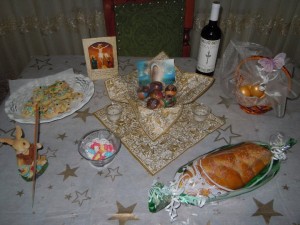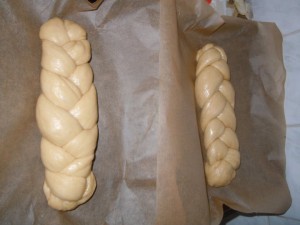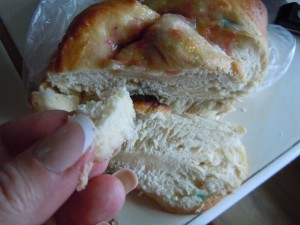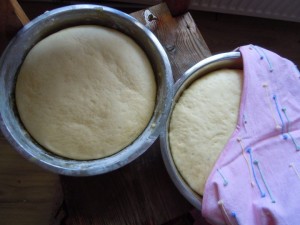 For over thirty years, Italian Easter Bread has been my traditional gift of sharing the celebration of the holiday with friends and family alike in the U.S. Now, as a Peace Corps volunteer, I remember how good it felt to work the dough and to talk with my grandma who always put so much care into the process of readying these for the tables of others. My grandma…that was in the early 1960’s…I am a grandmother myself now and in time, again, I will prepare the sweet braided loaves with my own granddaughter in the states. But for now, I think about how much it meant to have a taste of something so carefully done and to take in the aroma of the baking and watch the simple ingredients miraculously become a shining piece of art in the process. There are always complements and certainly when the last piece is gone, I always want to make some more for myself, well after Holy Week celebrations have finished. And so, of all the things that I cherish, I can look upon this activity as one of the most simple, yet profoundly emblematic of the time that it takes to nurture and mold something which is more than a bread, it’s a message of life and of giving. And it transcends borders. Since I’ve come to Romania I have been able to introduce many new foods to my neighbors here, one of them being this holiday treat. Especially as regards cuisine, the Romanian table is also very traditional as was with my Italian relatives. But, at times, it sorely lacks the gastronomic variety that comes from exposure to a host of different cultures such as we are privy to everyday back in America in restaurants, supermarkets or ethnic specialty stores. It is a joy for me to be able to make something so easily, with readily available ingredients, and at the same time take a few minutes to relax, reflect on the past, take it all in and then in the process be able to make the connection with another through the glory of deliciously homemade food. The symbolism of the breaking of the fast as well is not lost and at Easter, even though I live very far away from Charleston now, I can still be on familiar ground when recalling the purpose and the meaning behind the sharing of the bread. Like the little girl who once watched her Italian grandma, Carmella, in the kitchen that always smelled like licorice, while sitting at the naugahide and chrome table and chairs, drinking Red Rose tea with sugar and milk, waiting for the first piece of bread/cake with colored sprinkles that would someday be her way to a home away from home, I, too, now know that it has a meaning all it’s own.
For over thirty years, Italian Easter Bread has been my traditional gift of sharing the celebration of the holiday with friends and family alike in the U.S. Now, as a Peace Corps volunteer, I remember how good it felt to work the dough and to talk with my grandma who always put so much care into the process of readying these for the tables of others. My grandma…that was in the early 1960’s…I am a grandmother myself now and in time, again, I will prepare the sweet braided loaves with my own granddaughter in the states. But for now, I think about how much it meant to have a taste of something so carefully done and to take in the aroma of the baking and watch the simple ingredients miraculously become a shining piece of art in the process. There are always complements and certainly when the last piece is gone, I always want to make some more for myself, well after Holy Week celebrations have finished. And so, of all the things that I cherish, I can look upon this activity as one of the most simple, yet profoundly emblematic of the time that it takes to nurture and mold something which is more than a bread, it’s a message of life and of giving. And it transcends borders. Since I’ve come to Romania I have been able to introduce many new foods to my neighbors here, one of them being this holiday treat. Especially as regards cuisine, the Romanian table is also very traditional as was with my Italian relatives. But, at times, it sorely lacks the gastronomic variety that comes from exposure to a host of different cultures such as we are privy to everyday back in America in restaurants, supermarkets or ethnic specialty stores. It is a joy for me to be able to make something so easily, with readily available ingredients, and at the same time take a few minutes to relax, reflect on the past, take it all in and then in the process be able to make the connection with another through the glory of deliciously homemade food. The symbolism of the breaking of the fast as well is not lost and at Easter, even though I live very far away from Charleston now, I can still be on familiar ground when recalling the purpose and the meaning behind the sharing of the bread. Like the little girl who once watched her Italian grandma, Carmella, in the kitchen that always smelled like licorice, while sitting at the naugahide and chrome table and chairs, drinking Red Rose tea with sugar and milk, waiting for the first piece of bread/cake with colored sprinkles that would someday be her way to a home away from home, I, too, now know that it has a meaning all it’s own.
Natalie’s Italian Easter Bread Braids
1 cup milk
1 cup white sugar
1 Tbsp. pure anise extract (can be found at pharmacies in the cities, or, if you cannot find that, use 2 Tbsp. of brandy)
1/2 cup pure vegetable oil (something light like sunflower-not corn or olive)
1 package active dry yeast or one block of drojdie fresh
1/2 cup tepid water
5 cups unbleached white flour
3 whole eggs 1 tsp. salt
One beaten egg for glaze
Mini colored sprinkle dots
Some nice clear cellophane to wrap the breads in with pastel ribbons
Let’s Begin:
 First, scald the milk in a small pan on the stove until bubbly. Remove from heat and stir in the anise extract, the sugar and the oil. Let stand until lukewarm and not hot. Dissolve the yeast in the warm water in a large bowl.
First, scald the milk in a small pan on the stove until bubbly. Remove from heat and stir in the anise extract, the sugar and the oil. Let stand until lukewarm and not hot. Dissolve the yeast in the warm water in a large bowl.
Now add the milk mixture to the yeast and mix well. Then blend in the 3 well-beaten eggs.
Next, add in the salt. Then, mix in the flour with a wooden spoon, one cup at a time, until a soft dough forms. If you need to add more flour (the humidity and flour quality will determine this) then do, but sparingly. Add a bit more flour to a flat, clean surface and knead until smooth about 1o minutes. The dough should not be dry, pitted, or hard.
Time to Rest:
 Let rise in an oiled bowl covered with a clean towel in a warm place until doubled in bulk. This should be at least 1 hour to 1 hour and a half.
Let rise in an oiled bowl covered with a clean towel in a warm place until doubled in bulk. This should be at least 1 hour to 1 hour and a half.
After that, punch down the dough and cut into two pieces. Take each piece and knead out into a tube and cut into three more pieces each. Roll into tubes for making a braid by hand. You will make two large braids with this recipe. (You can make small braided rounds if you like to make the dough go farther that take about 25 minutes to cook thoroughly).
Place each on a cookie sheet lined with baking paper (the braids each should be almost the length of the pan) and let sit 30 minutes covered with a clean towel.
Bake to Perfection:
 Bake in a moderate oven for 40-50 minutes until a toothpick comes out clean when inserted in the center. The loaves should be a very light golden brown. The gas ovens here are tricky and super hot so watch carefully!
Bake in a moderate oven for 40-50 minutes until a toothpick comes out clean when inserted in the center. The loaves should be a very light golden brown. The gas ovens here are tricky and super hot so watch carefully!
When you remove the breads from the oven, take them with the paper out of the pan to limit further cooking and brush each with a beaten egg a few times to get a nice golden, rich color and to soften the crust. The aroma will be wonderful!
Decorate:
Sprinkle on the colored dots while the egg is still wet and then let cool completely away from drafts. Wrap in cellophone and pretty Eastertime ribbons to give as gifts on Easter Day after post is broken.
And, would somebody send me some more Anise Extract? Please!
Pofta Buna!

I would suggest some good Liquor -top quality Triple Sec.
Nice article. The pastry is a tough job, not easy.
Thanks for your wonderful presence in our world.
Dear Florin,
I apologize with all my heart that I missed this comment a while back and want to thank you so very much for your kind words. It is Romania which is the wonder in my life! Great tip on the liqueur, too…hope that all your holidays are happy and blessed.
Nu mai bine,
Natalie